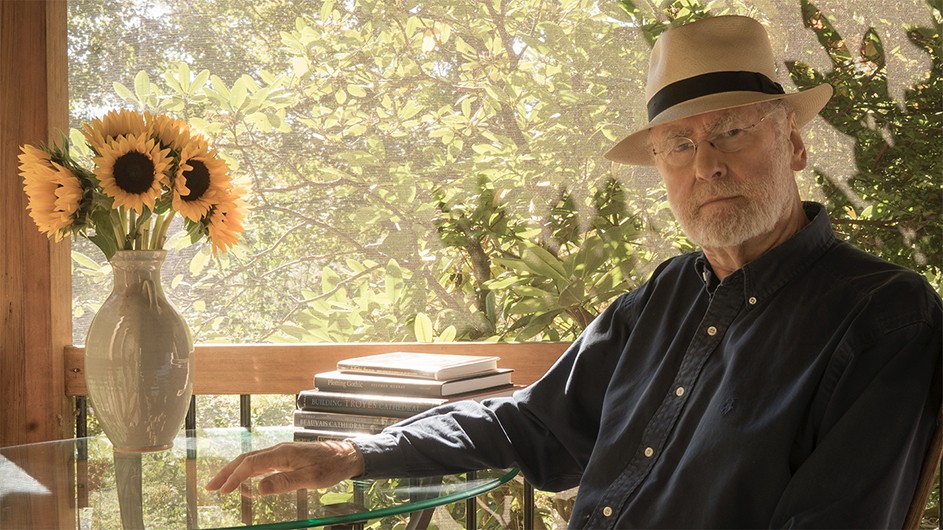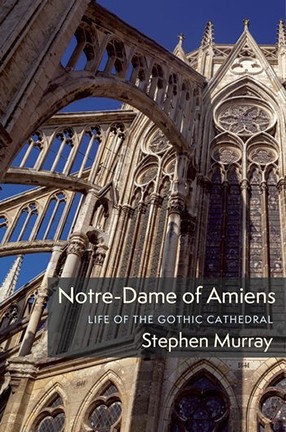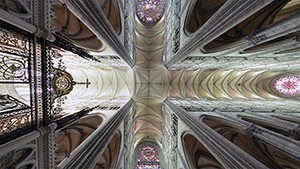A Gothic Cathedral Turns 800 Years Old
Professor Stephen Murray celebrates the construction and enduring relevance of Notre-Dame of Amiens in his new book.

Notre-Dame of Amiens in France is one of the great Gothic cathedrals of Europe. Its construction began in 1220, and artistic production in the Gothic mode lasted well into the 16th century.
In his new book, Notre-Dame of Amiens: Life of the Gothic Cathedral, Lisa and Bernard Selz Professor of Medieval Art History Emeritus Stephen Murray describes the building from a variety of perspectives and time periods, and celebrates the cathedral’s 800th anniversary. He discusses Notre-Dame of Amiens with Columbia News, as well as the ongoing restoration of Notre-Dame of Paris, what books he’s currently immersed in, and which scholars he would like to thank over dinner.
Q. What gave you the idea for this book?
A. There are two principal sources of inspiration. First, my 50-year engagement with the cathedral itself—a building that I first visited during Easter in 1969, and which has remained central in my life, never failing to entice and influence me. The city of Amiens adopted me as an honorary citizen in 1998, and Amiens’ University of Picardy, Jules Verne awarded me an honorary doctorate in 2019. Second, my 30-year commitment to teaching the students of the Columbia Core. It was in this context that I began to experiment with computer simulation, video, and animation in order to make the cathedral come alive in the classroom. The same context led me to a critical awareness of the role of the interlocutor and the power of story-telling.

Q. What makes Notre-Dame of Amiens such a distinctive Gothic cathedral?
A. Amiens Cathedral just feels right. Somehow, the designers managed to achieve the perfect combination of beauty, precariousness, and awe in order to induce a sense of the sublime. Beside Amiens, Reims and Chartres cathedrals feel heavy and uninspired. At the same time, the very imperfections in the edifice provide essential clues that allow us to tell the story of the builders.
Q. How did the various social groups—layfolk, clergy, artisans, builders—connected to the cathedral interact with the building and each other over the centuries?
A. The interaction of builders and users was far more complex than most modern visitors would expect. We are used to the notion of the separation of builders and users—yet in a cathedral, the builders were the users. The elite masons and upper level of city dwellers shared much of the same culture as the clergy, and the ordinary folk and laborers were bound to the cathedral by multiple ties of devotion and contractual relationships.

Q. Is the cathedral simply a relic, a thing of the past, or is it an enduring monument that is still relevant now?
A. The world response to the disastrous fire at Notre-Dame of Paris in April of 2019 provided an extraordinary demonstration of what that cathedral means to millions of people. After that calamity, Notre-Dame of Amiens received many visitors who otherwise would have gone to the Parisian cathedral. A cathedral compels us to enter and explore while, at the same time, points emphatically to the lives of the clergy and artisans who created it. The building animates the past and projects us to the future. It gives us hope.
Q. Have people been visiting the cathedral in Amiens during the pandemic?
A. The cathedral doors have remained open during the pandemic, but there are far fewer visitors than usual. Most of the celebrations and events associated with the 800th anniversary of the cathedral (1220-2020) were canceled.
Q. Let’s return to Notre-Dame of Paris. Has the restoration been moving forward despite COVID-19?
A. The cathedral is now sheltered under a provisional roof, the flying buttresses and damaged masonry have been shored up, and the stained glass removed. Two great cranes have facilitated the removal of the old fire-damaged scaffolding around the crossing. Rather than attempting a new high-tech spire, France decided to replicate the old one built in the mid-19th century by Viollet-le-Duc. It should be noted that the design of this spire was based upon the beautiful clocher doré (central steeple) of Amiens Cathedral. It is expected that services will resume at the cathedral in Paris in 2024.
Q. What's the last great book you read?
A. Sara Baume’s Spill, Simmer, Falter, Wither. The author provides a deeply moving portrait of the symbiotic—and, in some ways, salvific—relationship between two deeply flawed creatures, one human and the other, canine.
Q. What's on your reading list now?
A. My survival during the COVID sequestration owes much to my recent acquisition of a Kindle reader, which has led me to return to many of the old classics I read years ago—or which I should have read, but did not. I am currently marveling at Steinbeck’s ability in the Grapes of Wrath to weave together the diachronic dynamic of a gripping, forward-moving story with synchronic reflections—some of them almost lyrical—on the state of things, in nature as well as in human relations.
Q. What architectural history book can you recommend for getting through this pandemic winter?
A. I very much like Tom Nickson’s Toledo Cathedral: Building Histories in Medieval Castile. It is beautifully produced; the cathedral presents itself both through great images and readable text, and you are led to engage in the stories of the past.
Q. You're hosting a dinner party. Which three scholars or academics, dead or alive, would you invite and why?
A. I am feeling retrospective, and would like to converse with and thank three scholars—all now passed away—who really made a difference in my life and in the lives of many others: Howard Colvin, librarian of Saint John’s College, Oxford, who helped me find my path as an architectural historian, and who was a generous dinner host in Oxford. François Bucher, who was the most witty and creative of all the historians of medieval architecture. And Anne Prache, who was a great Gothic scholar and a most generous mentor of young Americans in Paris.